全细胞催化
- 格式:ppt
- 大小:169.50 KB
- 文档页数:20
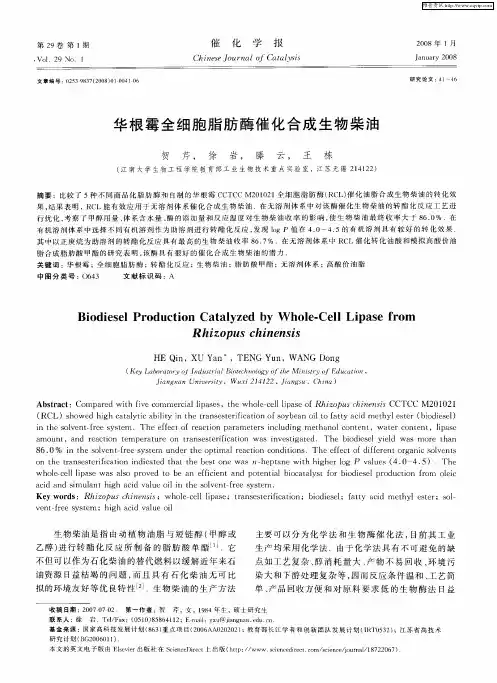


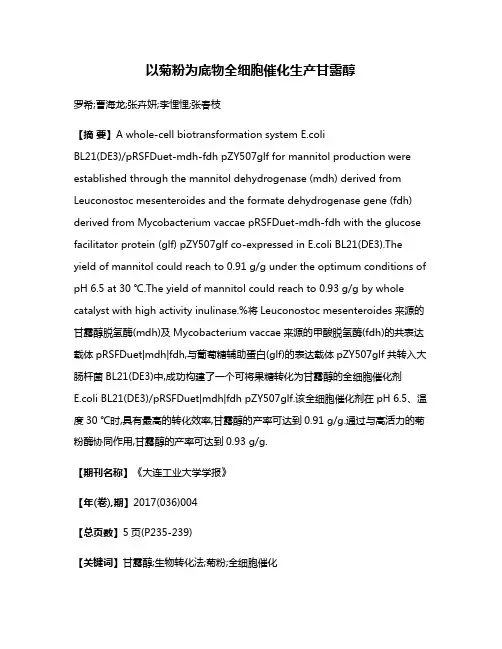
以菊粉为底物全细胞催化生产甘露醇罗希;曹海龙;张卉妍;李悝悝;张春枝【摘要】A whole-cell biotransformation system E.coliBL21(DE3)/pRSFDuet-mdh-fdh pZY507glf for mannitol production were established through the mannitol dehydrogenase (mdh) derived from Leuconostoc mesenteroides and the formate dehydrogenase gene (fdh) derived from Mycobacterium vaccae pRSFDuet-mdh-fdh with the glucose facilitator protein (glf) pZY507glf co-expressed in E.coli BL21(DE3).The yield of mannitol could reach to 0.91 g/g under the optimum conditions of pH 6.5 a t 30 ℃.The yield of mannitol could reach to 0.93 g/g by whole catalyst with high activity inulinase.%将Leuconostoc mesenteroides来源的甘露醇脱氢酶(mdh)及Mycobacterium vaccae来源的甲酸脱氢酶(fdh)的共表达载体pRSFDuet|mdh|fdh,与葡萄糖辅助蛋白(glf)的表达载体pZY507glf共转入大肠杆菌BL21(DE3)中,成功构建了一个可将果糖转化为甘露醇的全细胞催化剂E.coli BL21(DE3)/pRSFDuet|mdh|fdh pZY507glf.该全细胞催化剂在pH 6.5、温度30 ℃时,具有最高的转化效率,甘露醇的产率可达到0.91 g/g.通过与高活力的菊粉酶协同作用,甘露醇的产率可达到0.93 g/g.【期刊名称】《大连工业大学学报》【年(卷),期】2017(036)004【总页数】5页(P235-239)【关键词】甘露醇;生物转化法;菊粉;全细胞催化【作者】罗希;曹海龙;张卉妍;李悝悝;张春枝【作者单位】大连工业大学生物工程学院, 辽宁大连 116034;中国科学院大连化学物理研究所, 辽宁大连 116023;中国科学院大连化学物理研究所, 辽宁大连116023;中国科学院大连化学物理研究所, 辽宁大连 116023;大连工业大学生物工程学院, 辽宁大连 116034【正文语种】中文【中图分类】TS202.1;Q819甘露醇是一种六元糖醇,在医药、食品、化工和轻工等领域具有十分广泛的应用[1-3]。
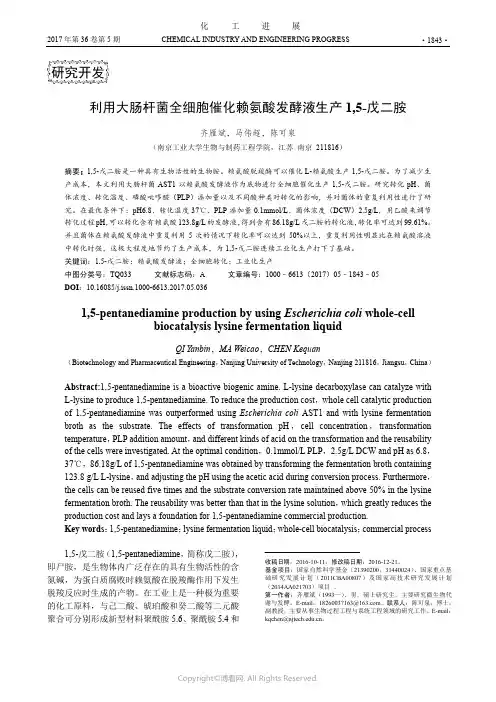
2017年第36卷第5期 CHEMICAL INDUSTRY AND ENGINEERING PROGRESS·1843·化 工 进展利用大肠杆菌全细胞催化赖氨酸发酵液生产1,5-戊二胺齐雁斌,马伟超,陈可泉(南京工业大学生物与制药工程学院,江苏 南京 211816)摘要:1,5-戊二胺是一种具有生物活性的生物胺。
赖氨酸脱羧酶可以催化L-赖氨酸生产1,5-戊二胺。
为了减少生产成本,本文利用大肠杆菌AST1以赖氨酸发酵液作为底物进行全细胞催化生产1,5-戊二胺。
研究转化pH 、菌体浓度、转化温度、磷酸吡哆醛(PLP )添加量以及不同酸种类对转化的影响,并对菌体的重复利用性进行了研究。
在最优条件下:pH6.8、转化温度37℃、PLP 添加量0.1mmol/L 、菌体浓度(DCW )2.5g/L ,用乙酸来调节转化过程pH ,可以转化含有赖氨酸123.8g/L 的发酵液,得到含有86.18g/L 戊二胺的转化液,转化率可达到99.61%。
并且菌体在赖氨酸发酵液中重复利用5次的情况下转化率可以达到50%以上,重复利用性明显比在赖氨酸溶液中转化时强,这极大程度地节约了生产成本,为1,5-戊二胺连续工业化生产打下了基础。
关键词:1,5-戊二胺;赖氨酸发酵液;全细胞转化;工业化生产中图分类号:TQ033 文献标志码:A 文章编号:1000–6613(2017)05–1843–05 DOI :10.16085/j.issn.1000-6613.2017.05.0361,5-pentanediamine production by using Escherichia coli whole-cellbiocatalysis lysine fermentation liquidQI Yanbin ,MA Weicao ,CHEN Kequan(Biotechnology and Pharmaceutical Engineering ,Nanjing University of Technology ,Nanjing 211816,Jiangsu ,China )Abstract:1,5-pentanediamine is a bioactive biogenic amine. L-lysine decarboxylase can catalyze with L-lysine to produce 1,5-pentanediamine. To reduce the production cost ,whole cell catalytic production of 1,5-pentanediamine was outperformed using Escherichia coli AST1 and with lysine fermentation broth as the substrate. The effects of transformation pH ,cell concentration ,transformation temperature ,PLP addition amount ,and different kinds of acid on the transformation and the reusability of the cells were investigated. At the optimal condition ,0.1mmol/L PLP ,2.5g/L DCW and pH as 6.8,37℃,86.18g/L of 1,5-pentanediamine was obtained by transforming the fermentation broth containing 123.8 g/L L-lysine ,and adjusting the pH using the acetic acid during conversion process. Furthermore ,the cells can be reused five times and the substrate conversion rate maintained above 50% in the lysine fermentation broth. The reusability was better than that in the lysine solution ,which greatly reduces the production cost and lays a foundation for 1,5-pentanediamine commercial production. Key words :1,5-pentanediamine ;lysine fermentation liquid ;whole-cell biocatalysis ;commercial process1,5-戊二胺(1,5-pentanediamine ,简称戊二胺),即尸胺,是生物体内广泛存在的具有生物活性的含氮碱,为蛋白质腐败时赖氨酸在脱羧酶作用下发生脱羧反应时生成的产物。
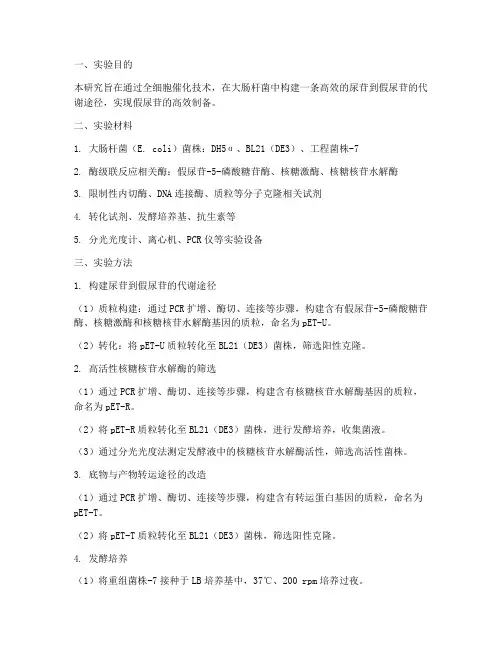
一、实验目的本研究旨在通过全细胞催化技术,在大肠杆菌中构建一条高效的尿苷到假尿苷的代谢途径,实现假尿苷的高效制备。
二、实验材料1. 大肠杆菌(E. coli)菌株:DH5α、BL21(DE3)、工程菌株-72. 酶级联反应相关酶:假尿苷-5-磷酸糖苷酶、核糖激酶、核糖核苷水解酶3. 限制性内切酶、DNA连接酶、质粒等分子克隆相关试剂4. 转化试剂、发酵培养基、抗生素等5. 分光光度计、离心机、PCR仪等实验设备三、实验方法1. 构建尿苷到假尿苷的代谢途径(1)质粒构建:通过PCR扩增、酶切、连接等步骤,构建含有假尿苷-5-磷酸糖苷酶、核糖激酶和核糖核苷水解酶基因的质粒,命名为pET-U。
(2)转化:将pET-U质粒转化至BL21(DE3)菌株,筛选阳性克隆。
2. 高活性核糖核苷水解酶的筛选(1)通过PCR扩增、酶切、连接等步骤,构建含有核糖核苷水解酶基因的质粒,命名为pET-R。
(2)将pET-R质粒转化至BL21(DE3)菌株,进行发酵培养,收集菌液。
(3)通过分光光度法测定发酵液中的核糖核苷水解酶活性,筛选高活性菌株。
3. 底物与产物转运途径的改造(1)通过PCR扩增、酶切、连接等步骤,构建含有转运蛋白基因的质粒,命名为pET-T。
(2)将pET-T质粒转化至BL21(DE3)菌株,筛选阳性克隆。
4. 发酵培养(1)将重组菌株-7接种于LB培养基中,37℃、200 rpm培养过夜。
(2)按1%接种量接种于发酵培养基中,37℃、200 rpm发酵培养24小时。
(3)发酵结束后,离心收集菌体,测定假尿苷产量。
四、实验结果1. 重组菌株-7在24小时内全细胞催化30g/L尿苷产生27.24g/L假尿苷,转化率为90.8%,生产效率为1.135g/(L·h)。
2. 通过分光光度法测定,重组菌株-7的假尿苷产量和生产效率为现有酶催化法报道的最高值。
五、实验讨论1. 本实验通过构建尿苷到假尿苷的代谢途径,实现了假尿苷的高效制备。
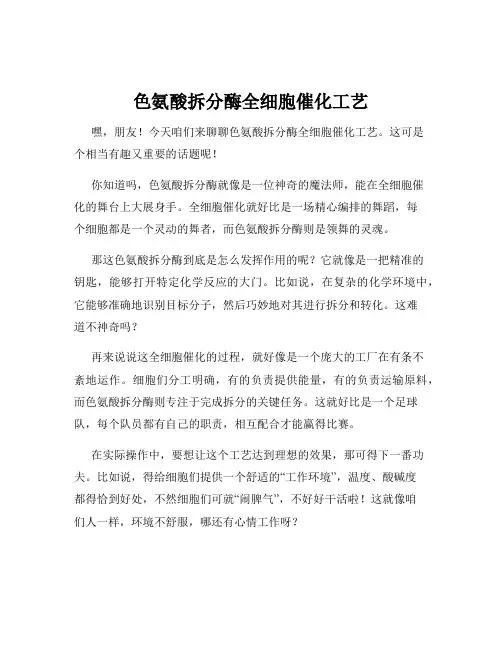
色氨酸拆分酶全细胞催化工艺嘿,朋友!今天咱们来聊聊色氨酸拆分酶全细胞催化工艺。
这可是个相当有趣又重要的话题呢!你知道吗,色氨酸拆分酶就像是一位神奇的魔法师,能在全细胞催化的舞台上大展身手。
全细胞催化就好比是一场精心编排的舞蹈,每个细胞都是一个灵动的舞者,而色氨酸拆分酶则是领舞的灵魂。
那这色氨酸拆分酶到底是怎么发挥作用的呢?它就像是一把精准的钥匙,能够打开特定化学反应的大门。
比如说,在复杂的化学环境中,它能够准确地识别目标分子,然后巧妙地对其进行拆分和转化。
这难道不神奇吗?再来说说这全细胞催化的过程,就好像是一个庞大的工厂在有条不紊地运作。
细胞们分工明确,有的负责提供能量,有的负责运输原料,而色氨酸拆分酶则专注于完成拆分的关键任务。
这就好比是一个足球队,每个队员都有自己的职责,相互配合才能赢得比赛。
在实际操作中,要想让这个工艺达到理想的效果,那可得下一番功夫。
比如说,得给细胞们提供一个舒适的“工作环境”,温度、酸碱度都得恰到好处,不然细胞们可就“闹脾气”,不好好干活啦!这就像咱们人一样,环境不舒服,哪还有心情工作呀?还有啊,选择合适的细胞种类也至关重要。
不同的细胞就像是不同性格的员工,有的干活儿利索,有的可能就稍微慢点。
所以得精挑细选,找到那些最适合的“员工”,才能让这个催化工艺高效运转。
而且,原料的质量和供应也不能马虎。
这就好比做饭,食材不好,再厉害的大厨也做不出美味佳肴。
所以要保证原料的纯净和充足,这样色氨酸拆分酶才能施展出它的全部本领。
总之,色氨酸拆分酶全细胞催化工艺是一门精妙的学问。
要想把它运用好,就得像照顾一个精密的仪器一样,每个环节都要精心呵护,每个细节都要考虑周全。
只有这样,才能让这个神奇的工艺发挥出最大的作用,为我们的科学研究和实际应用带来更多的惊喜和可能!。
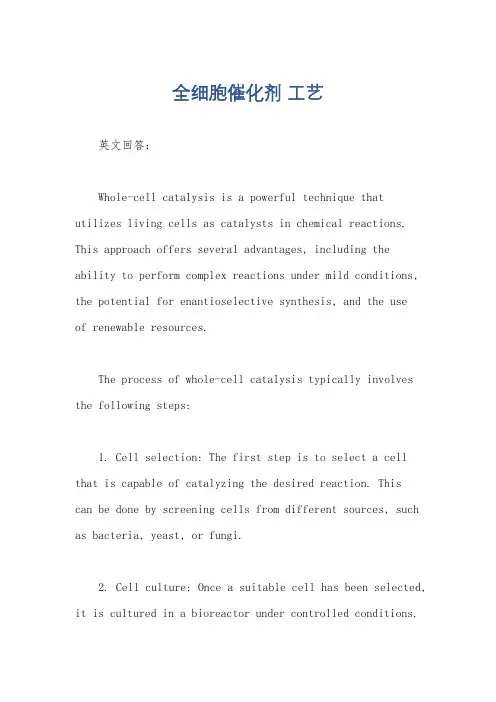
全细胞催化剂工艺英文回答:Whole-cell catalysis is a powerful technique thatutilizes living cells as catalysts in chemical reactions. This approach offers several advantages, including theability to perform complex reactions under mild conditions, the potential for enantioselective synthesis, and the useof renewable resources.The process of whole-cell catalysis typically involves the following steps:1. Cell selection: The first step is to select a cell that is capable of catalyzing the desired reaction. Thiscan be done by screening cells from different sources, such as bacteria, yeast, or fungi.2. Cell culture: Once a suitable cell has been selected, it is cultured in a bioreactor under controlled conditions.The growth medium is typically optimized to provide thecells with the nutrients and cofactors they need to produce the desired enzyme.3. Enzyme production: The next step is to induce the cells to produce the enzyme that will catalyze the reaction. This can be done by adding a chemical inducer to the growth medium or by genetically engineering the cells to express the enzyme constitutively.4. Reaction: Once the cells have produced the enzyme, the reaction can be carried out by adding the substrates to the bioreactor. The cells will then catalyze the reaction, producing the desired product.5. Product recovery: The final step is to recover the product from the bioreactor. This can be done by filtration, centrifugation, or other methods.Whole-cell catalysis has been used to synthesize a wide variety of chemicals, including pharmaceuticals, fine chemicals, and biofuels. This technology is still in itsearly stages of development, but it has the potential to revolutionize the chemical industry.中文回答:全细胞催化剂工艺。

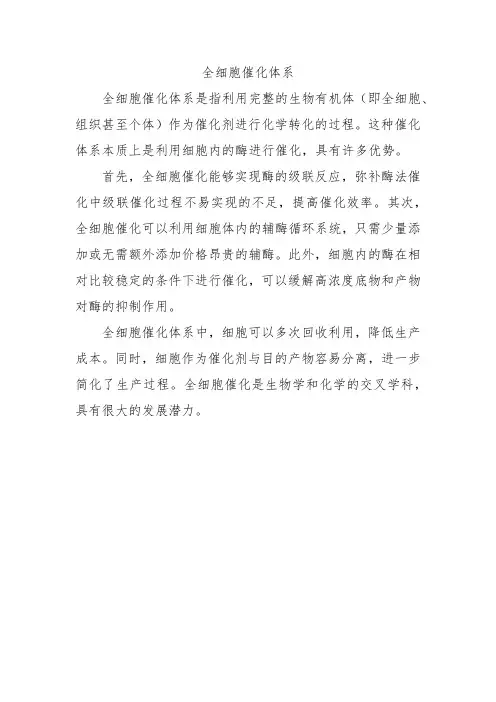
全细胞催化体系
全细胞催化体系是指利用完整的生物有机体(即全细胞、组织甚至个体)作为催化剂进行化学转化的过程。
这种催化体系本质上是利用细胞内的酶进行催化,具有许多优势。
首先,全细胞催化能够实现酶的级联反应,弥补酶法催化中级联催化过程不易实现的不足,提高催化效率。
其次,全细胞催化可以利用细胞体内的辅酶循环系统,只需少量添加或无需额外添加价格昂贵的辅酶。
此外,细胞内的酶在相对比较稳定的条件下进行催化,可以缓解高浓度底物和产物对酶的抑制作用。
全细胞催化体系中,细胞可以多次回收利用,降低生产成本。
同时,细胞作为催化剂与目的产物容易分离,进一步简化了生产过程。
全细胞催化是生物学和化学的交叉学科,具有很大的发展潜力。